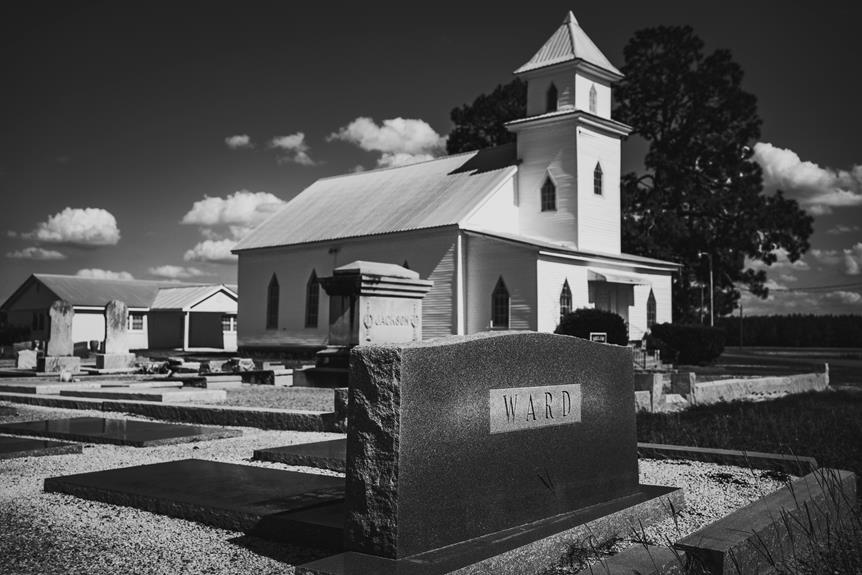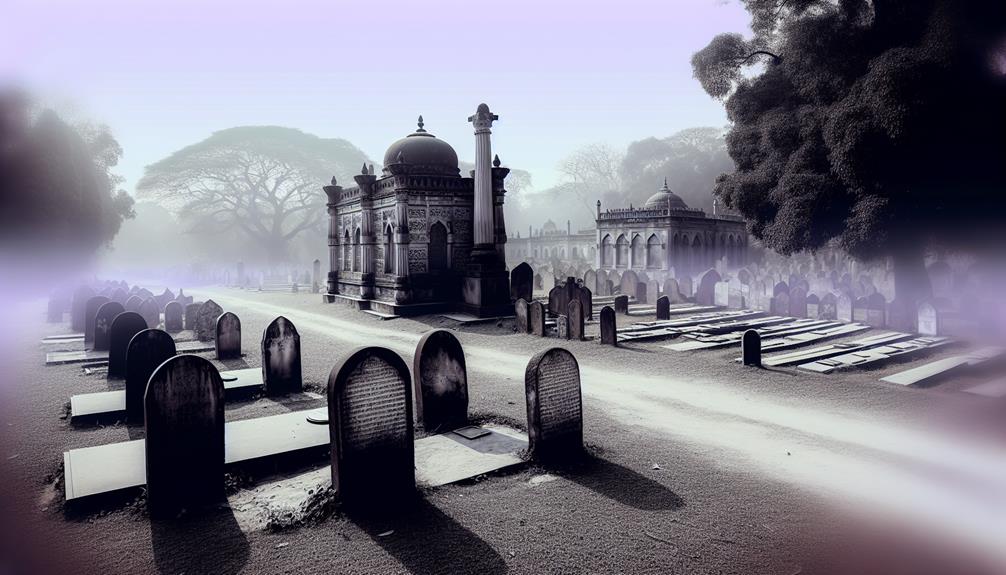The solemn grounds of Arlington National Cemetery stand as a tribute to the valor and sacrifice of those who served the United States. Steeped in history and reverence, this hallowed site offers a poignant glimpse into the nation's military legacy. From the meticulously choreographed Changing of the Guard at the Tomb of the Unknown Soldier to the poignant symbolism of the Eternal Flame, each corner of Arlington National Cemetery holds stories waiting to be revealed, inviting visitors to explore the profound depths of honor and memory that reside within its borders.
Key Takeaways
- Established during Civil War for fallen soldiers.
- Houses notable graves like JFK and Unknown Soldier.
- Conducts Changing of the Guard ceremony daily.
- Features Memorial Amphitheater for military ceremonies.
- Symbolizes honor, remembrance, and gratitude for service.
Historical Background
In tracing the historical background of Arlington National Cemetery in the United States, it is important to explore the intricate tapestry of events that led to its establishment as a hallowed ground of national significance.
The origins of Arlington National Cemetery date back to the American Civil War. As casualties mounted during the conflict, the need for a final resting place for fallen soldiers became apparent. In response to this necessity, the estate of Confederate General Robert E. Lee, Arlington House, was chosen as the site for a military cemetery. This decision not only provided a practical solution to the burial crisis but also held symbolic significance by repurposing the property of a prominent figure in the Confederacy.
The significance of Arlington National Cemetery extends beyond its initial purpose as a burial ground for Civil War soldiers. Over time, it has evolved into a poignant symbol of honor and remembrance for all those who have served in the United States Armed Forces. The cemetery stands as a tribute to the sacrifices made by countless men and women in defense of freedom and democracy. Each gravestone tells a story of bravery, dedication, and service to the nation, reinforcing the idea that freedom is not free.
Arlington National Cemetery serves as a place where the past is honored, the present is respected, and the future is inspired by the legacy of those who rest on its grounds.
Notable Gravesites
Among the many distinguished individuals interred at Arlington National Cemetery in the United States, notable gravesites encompass a rich tapestry of history and honor. The cemetery serves as the final resting place for numerous famous burials, including President John F. Kennedy, whose eternal flame is a symbol of his enduring legacy. Additionally, Arlington is the burial site for the Tomb of the Unknown Soldier, representing all unidentified and missing soldiers who gave their lives in service to the nation.
Famous burials at Arlington National Cemetery also include General George C. Marshall, a key architect of victory in World War II, and Supreme Court Justice Thurgood Marshall, the first African American to serve on the nation's highest court. The cemetery is a poignant reminder of the sacrifices made by decorated veterans, such as Audie Murphy, the most decorated American soldier of World War II, and Admiral Arleigh Burke, a renowned naval officer.
The gravesites of these notable individuals not only honor their contributions to the nation but also stand as a tribute to the values of courage, service, and dedication. Visitors to Arlington National Cemetery can pay their respects to these heroes and reflect on the profound impact they had on American history and the defense of freedom.
Changing of the Guard
Located at Arlington National Cemetery in the United States, the Changing of the Guard ceremony is a revered tradition that pays tribute to fallen soldiers and embodies the utmost respect and honor for those who have sacrificed for their country. This ceremonial tradition takes place at the Tomb of the Unknown Soldier, a monument dedicated to the unidentified soldiers who lost their lives in war. The Changing of the Guard occurs every hour on the hour from October 1 to March 31, and every half-hour from April 1 to September 30, regardless of weather conditions.
During the ceremony, members of the 3rd U.S. Infantry Regiment, also known as 'The Old Guard,' carry out the meticulous ritual. The soldiers who participate in this duty are specially trained and display unwavering discipline and precision. The solemn procession includes a series of symbolic gestures and movements that signify the continuity of the military honor and the eternal vigilance over the fallen.
Visitors who witness the Changing of the Guard often describe it as a moving experience that evokes a sense of patriotism and gratitude. The ceremony serves as a poignant reminder of the sacrifices made by servicemen and women throughout history, reinforcing the values of duty, honor, and country. The Changing of the Guard at Arlington National Cemetery stands as a powerful symbol of respect and remembrance for those who have given their lives in service of the nation.
Memorial Amphitheater
The Memorial Amphitheater at Arlington National Cemetery serves as a revered site for ceremonies and events honoring the sacrifices of servicemen and women throughout history. This grand structure, with its neoclassical design and impressive colonnade, stands as a symbol of national pride and reverence. The amphitheater's architecture, characterized by its Doric columns and marble construction, provides a solemn backdrop for military ceremonies that pay tribute to the fallen heroes who have served the United States.
Within the Memorial Amphitheater, the Tomb of the Unknown Soldier stands as a poignant reminder of the sacrifices made by unidentified servicemen. The Changing of the Guard ceremony, held at the Tomb, is a solemn ritual that underscores the nation's commitment to honoring those who have given their lives in service.
The amphitheater's significance extends beyond its architectural beauty; it embodies national symbolism and serves as a focal point for veteran tributes. Various events, such as Memorial Day and Veterans Day ceremonies, are held at the amphitheater to honor and remember the brave individuals who have served in the U.S. Armed Forces.
Women in Military Service
Highlighting the integral role of women in the U.S. military, their contributions resonate profoundly with the values of honor and sacrifice exemplified at Arlington National Cemetery. Women have a long history of service in the military, dating back to the Revolutionary War where they served in various supportive roles. Over time, their roles expanded, and they have become indispensable members of the armed forces, serving in combat, leadership positions, and other essential roles.
Women in the military not only serve their country but also serve as role models for future generations. Their presence in the military has helped break down barriers and stereotypes, showing that bravery, dedication, and leadership know no gender. By honoring women's military service at Arlington National Cemetery, it reinforces the importance of their contributions and sacrifices.
The journey towards equality in combat roles has been a significant one, with women now being able to serve in combat positions across all branches of the military. This progress reflects a commitment to fairness and the recognition of the capabilities of all service members, regardless of gender.
As more women continue to serve in the military and make valuable contributions, it is essential to acknowledge and celebrate their achievements. Arlington National Cemetery stands as a tribute to the courage and commitment of all those who have served, including the countless women who have played a crucial role in defending freedom and democracy.
Tomb of the Unknown Soldier
An enduring symbol of reverence and remembrance within Arlington National Cemetery is the Tomb of the Unknown Soldier. This sacred monument stands as a tribute to the sacrifices made by unidentified soldiers in service to their country. The tomb represents all those who have given their lives in defense of freedom, yet whose names remain unknown.
Military honors are bestowed upon the Tomb of the Unknown Soldier daily. The precision and solemnity of the Changing of the Guard ceremony are a poignant display of respect for these unnamed heroes. The soldiers of the 3rd U.S. Infantry Regiment, also known as 'The Old Guard,' carry out this duty with meticulous care, honoring the memory of the fallen with each step they take.
The Tomb of the Unknown Soldier serves as a focal point for national remembrance. It is a place where visitors from around the world come to pay their respects and reflect on the cost of liberty. The marble sarcophagus, adorned with three Greek figures representing Peace, Victory, and Valor, is a powerful reminder of the courage and selflessness of those who serve in the armed forces.
Eternal Flame
Adjacent to the Tomb of the Unknown Soldier at Arlington National Cemetery stands the Eternal Flame, embodying perpetual reverence and honor for the fallen heroes who have sacrificed for their nation. The Eternal Flame holds significant symbolism, representing undying gratitude and remembrance for the brave individuals who gave their lives in service to the United States.
Eternal Flame Symbolism:
- Symbol of Sacrifice: The Eternal Flame symbolizes the eternal spirit of those who made the ultimate sacrifice for their country, serving as a beacon of hope and gratitude.
- Continuity of Remembrance: It serves as a constant reminder of the unending respect and appreciation for the dedication and valor of the fallen soldiers.
- National Unity: The Eternal Flame unites the nation in honoring the memory of all those who fought and died for the principles of freedom and democracy.
The maintenance procedures for the Eternal Flame are meticulously carried out to uphold its uninterrupted glow. Regular inspections, cleaning, and fuel replenishment are part of the routine maintenance to uphold the flame's symbolism and significance. The perpetual nature of the flame requires strict adherence to maintenance protocols to guarantee that it continues to burn brightly, paying tribute to the sacrifices of the fallen heroes for generations to come.
Wreath-Laying Ceremonies
Wreath-laying ceremonies at Arlington National Cemetery exemplify a solemn tradition deeply rooted in honoring the service and sacrifice of military personnel who have bravely served their country. These ceremonies, steeped in veteran traditions, serve as poignant reminders of the sacrifices made by servicemen and women to uphold the values of freedom and democracy.
At Arlington National Cemetery, wreath-laying ceremonies hold great significance, with each wreath symbolizing a token of gratitude and remembrance for the fallen heroes who rest in this hallowed ground. The meticulous arrangement of the wreaths and the respectful manner in which they are placed convey a sense of reverence and honor that transcends words.
One of the most prestigious moments during these ceremonies is when the President of the United States participates in the wreath-laying, offering presidential honors to the fallen heroes. This gesture not only pays tribute to the individuals who served the nation with unwavering dedication but also underscores the nation's commitment to never forget their ultimate sacrifice.
| Aspects of Wreath-Laying Ceremonies |
|---|
| Symbolism of Wreaths |
| Presidential Participation |
| Veteran Traditions |
Frequently Asked Questions
Can Visitors Bring Their Own Flowers to Place on Graves?
Visitors often inquire about the etiquette and guidelines regarding the placement of floral arrangements at memorial sites. Many individuals wish to personalize their tribute by bringing their own flowers.
Understanding the importance of honoring the deceased, it is imperative to follow any specific regulations in place at the location. By adhering to any rules set forth, visitors can guarantee their gestures of remembrance are respectful and contribute positively to the memorial atmosphere.
Are There Any Restrictions on Photography Within the Cemetery?
Just as a camera lens captures fleeting moments, photography regulations at solemn locations like cemeteries aim to preserve dignity and respect.
When considering the sensitive nature of these sites, it is crucial to adhere to guidelines that promote thoughtful and respectful behavior.
Understanding and following photography regulations in such spaces guarantees that visitors can pay homage without disrupting the solemn atmosphere that surrounds them.
How Are the Gravesites Maintained and Cared For?
Gravesite preservation is a meticulous process involving regular maintenance, including grass cutting, landscaping, and headstone cleaning. The care and upkeep of these final resting places are crucial to honor the memory of those interred there.
Floral tributes play a significant role in this preservation, adding a touch of respect and remembrance. The meticulous attention to detail guarantees that these sacred spaces remain dignified and well-kept for visitors paying their respects.
Is There a Specific Protocol for Visitors During Ceremonies?
Visitor etiquette at ceremonies is essential for maintaining decorum and respect. Following ceremony customs, visitors are often expected to maintain silence, stand when appropriate, and refrain from any disruptive behavior.
It is customary to dress in a respectful manner, avoid any unnecessary distractions, and adhere to the instructions provided by the ceremony organizers. By observing these protocols, visitors can honor the significance of the event and pay tribute to those being commemorated.
Are There Any Special Events or Tours Available for Visitors?
Guided tours and special events offer visitors unique opportunities to engage with the site's history and pay respects. Understanding visitor etiquette is essential, as it guarantees a respectful and meaningful experience.
Additionally, participating in flag placement ceremonies can be a powerful way to honor those who have served. These activities provide a deeper connection to the significance of the location and the sacrifices made by those interred.
Conclusion
In the midst of Arlington National Cemetery's hallowed grounds, the Tomb of the Unknown Soldier stands as a powerful symbol of sacrifice and reverence. Just as the changing of the guard at this sacred site signifies the eternal vigilance and honor bestowed upon those who served, so too does the entire cemetery serve as a poignant reminder of the courage and dedication of America's military members.


